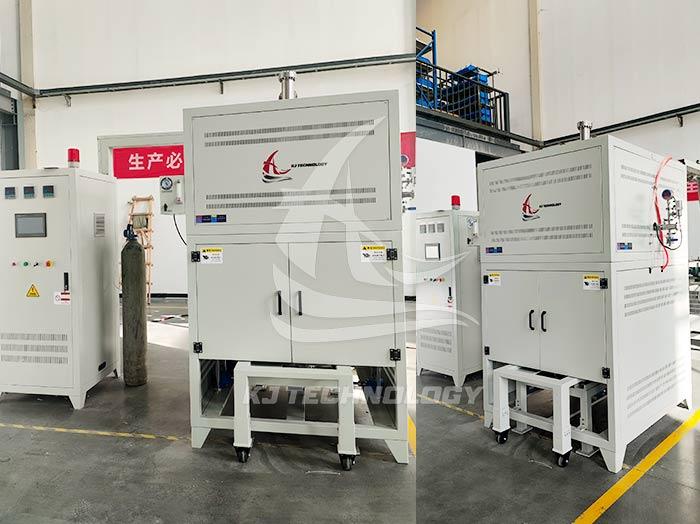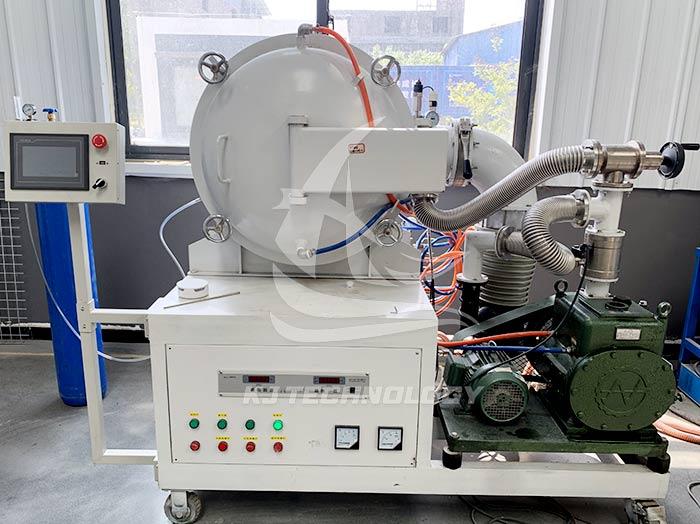Heat treatment vacuum furnace
 09-10-2025 Author: KJ technology
09-10-2025 Author: KJ technology
Heat treatment vacuum furnace is an advanced industrial equipment that combines vacuum technology with heat treatment technology. By creating an environment close to vacuum inside the furnace cavity, it eliminates adverse reactions such as oxidation and decarburization, thereby achieving high-purity and high-performance processing of materials. The following provides a detailed introduction from five aspects: working principle, structural composition, technical characteristics, application fields, and selection suggestions:
1. Working principle
The heat treatment vacuum furnace extracts air from the furnace chamber through a vacuum system (consisting of a vacuum pump, vacuum measuring device, vacuum valve, etc.) to a pressure lower than standard atmospheric pressure, forming a vacuum or low-pressure environment. In this environment, the material hardly reacts with oxygen, water vapor, etc. during heating, avoiding defects such as oxide film formation, decarburization, and carbonization. At the same time, precise temperature control is achieved through radiation heat transfer, meeting the strict requirements of the material for temperature uniformity.
2. Structural composition
Furnace body: welded from carbon steel or stainless steel, using a double-layer water jacket structure, preventing deformation of the furnace shell and deterioration of the sealing material through water cooling or gas cooling. The furnace door is driven by gears and racks to achieve flexible opening and closing.
Heating system: Depending on the purpose, heating elements such as resistors, induction coils, electrodes, or electron guns can be configured in the furnace. For example, vacuum furnaces for melting metals are equipped with crucibles and automatic pouring devices.
Vacuum system: composed of vacuum pump, vacuum valve, and vacuum gauge, responsible for pumping, maintaining vacuum degree, and monitoring pressure changes.
Sealing structure: Vacuum sealing materials are used for the joint surface of the furnace body, water-cooled electrodes, thermocouple export devices, etc., to ensure that the leakage rate meets the standards.
Automation control system: Integrated temperature, pressure, time and other parameter control modules, supporting full process automation operations such as program heating, insulation, cooling, etc.
3. Technical features
Non oxidation and decarburization treatment: Vacuum environment eliminates oxidizing gases, avoids the formation of oxide film or decarburization layer on the material surface, and maintains the metallic luster and original properties.
Surface Bright Purification: By degreasing and degassing, impurities such as phosphorus chips and oil stains on the surface of the workpiece are removed, achieving surface purification.
Small deformation and high qualification rate: The workpiece is heated slowly, with a small temperature difference and low thermal stress. The deformation is significantly smaller than that of conventional heat treatment, and the product qualification rate is improved.
Energy saving and environmental protection: high thermal efficiency, capable of rapid temperature rise and fall; No combustion process, reducing energy consumption; No emissions of exhaust gas or wastewater, meeting the requirements of green manufacturing.
Accurate temperature control: using radiation heat transfer, temperature uniformity is better than ± 5 ℃, meeting the requirements of precision machining.
Wide material adaptability: suitable for cold and hot work mold steel, high-speed steel, high-temperature alloys, titanium alloys, magnetic materials, etc. It can handle active metals (such as Ti, Zr) and refractory metals (such as W, Mo).
4. Application Fields
Metal heat treatment: including quenching, annealing, tempering, solution treatment, aging treatment, etc., to enhance material strength, hardness, corrosion resistance, and electrical conductivity. For example, aerospace alloy melting relies on vacuum furnaces to ensure stability in extreme environments.
Semiconductor processing: used for silicon wafer annealing, doping and other processes to control impurity content and improve device performance.
Ceramic and glass industry: achieve precision ceramic sintering, glass annealing, avoid cracking, and improve density and transmittance.
In the field of new energy, we support the recycling of lithium-ion battery cathode materials and the synthesis of solid electrolytes to improve resource utilization and material performance.
Aerospace: Processing high-temperature alloys such as turbine blades and engine components to meet lightweight and high-strength requirements.
5. Selection suggestions
Extreme temperature and vacuum degree: selected according to material processing requirements. For example, aerospace companies require a vacuum degree of 10 ⁻⁵ Pa and a high temperature configuration of 2200 ℃, while jewelry processing can choose models with 10 ⁻² Pa and 1200 ℃.
Heating method: Resistance heating is suitable for small and medium-sized furnaces, induction heating is suitable for large or rapid heating scenarios, and electron gun heating is used for high melting point materials.
Cooling method: Gas quenching (such as nitrogen and argon) is suitable for rapid cooling, oil quenching is used for materials with high hardenability requirements, and water quenching should be carefully selected to avoid cracking.
Automation level: Select manual, semi-automatic, or fully automatic models according to production scale. Automated models can reduce human errors and improve production efficiency.
After sales service: Priority should be given to suppliers that provide 72 hour global spare parts delivery and a core component warranty of more than 5 years to ensure rapid response in emergency situations.








